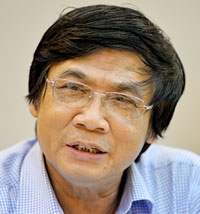 Opinion
Opinion

Architect Trần Ngọc Chính, Chairman of Việt Nam Urban Planning and Development, spoke to the newspaper Kinh Tế & Đô thị (Economic and Urban Affairs) about the need for tough policies in urban planning and management
 |
| Trần Ngọc Chính. |
Architect Trần Ngọc Chính, Chairman of Việt Nam Urban Planning and Development, spoke to the newspaper Kinh Tế & Đô thị (Economic and Urban Affairs) about the need for tough policies in urban planning and management
The Capital Law has been in force for three years, do you see any major changes in construction planning and law and order in the city?
The Capital Law is an acknowledgement of the important role played by Hà Nội. In the process of its compilation, the law took into account the desire of the general public for a comprehensive law for a modern and civilised city.
Following its expansion in 2008, Hà Nội covers an area of 3,344 sq. km. The then-Prime Minister had already approved Hà Nội’s development plan by 2030 and the vision for 2050.
Under the Capital Law, Hà Nội will have three main functional regions: the central area, satellite cities and eco urban towns. Under the city’s development plan, there will be a detailed plan for the development of Hà Nội’s key infrastructure development, water supply and sewage system, as well as hospitals, schools, research institutes and others.
Some key landmarks have been constructed since 2008, like the Nhật Tân Bridge, Võ Nguyên Giáp Road, the T2 Terminal of Nội Bài International Airport and many others.
In your opinion, what are the remaining issues that city authorities must overcome in the future?
There remain some issues that must be addressed as soon as possible.
First is the frequent traffic congestion. Many people consider it a nightmare.
Of course, there are several reasons for the traffic problem, including rapid urbanisation, high population growth – particularly in the city’s inner areas. Meanwhile, some modern traffic systems, like the Metro or Bus Rapid Transits (BRTs), have not been completed.
Secondly, pavements have been misused for commercial purposes. Pavement economy needs to be resolved as soon as possible as this is a very important factor in communication and culture of a capital city. One of Hà Nội’s objectives is to turn the city into a green, civilised and modern city. But in reality, this objective has not been properly addressed.
Thirdly, is the problem of the city’s sewage system. Following heavy rainfalls, many down town and new urban areas become rivers and canals. This has become a nightmare for many people and caused a lot of damage to health and property.
Last but not least is the problem of “super thin and abnormally shaped houses” resulting from road expansions/enlargement.
Linh Đàm and Phú Mỹ Hưng, urban areas in Hà Nội and HCM City respectively, have been chosen as two role models in urban development. But in my opinion, housing construction in the Linh Đàm urban area has not followed the construction law. How do you respond to that?
I can’t agree more. Both the Linh Đàm and Phú Mỹ Hưng new urban areas have been chosen by the Ministry of Construction as role models. However, many new buildings have not adhered to the standards set for the new urban areas. A case in point, in an area of a bit over four hectares, 12 tall buildings with 38-41 storeys have been built without any land reserved for trees. This is unacceptable.
What should we do to implement the Capital Law, particularly in land planning and architecture?
There are several things we must do right now.
Firstly, we have to review the current planning activities, ranging from the overall planning to the detailed one.
Secondly, we should conduct a study on the moving of all or part of universities, hospitals, offices, factories from inner cities to outlying areas, in line with the sprite of the Capital Law. This is a good and effective way to lessen the pressure on the inner capital city and it is in line with the spirit of the Capital Law on reducing the inner city population, easing the pressure on the city’s infrastructure while creating more land for developing public projects.
And finally, special projects should be developed to give the capital a new face, including big parks, a system of museums, expo centres, national theatres and others.
In my opinion, we should create a steering committee or a national committee tasked with the planning activity and architecture, in line with the Capital Law. Whatever plan we are going to adopt, it must be geared toward turning Hà Nội into a green, civilised and modern city. — VNS




